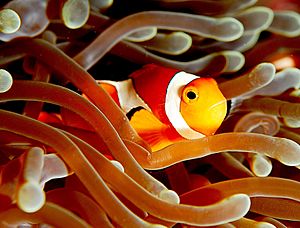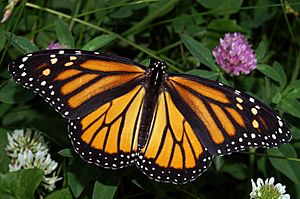Life (British TV series) facts for kids
Quick facts for kids Life |
|
|---|---|
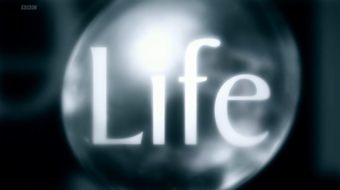
Series title card from UK broadcast
|
|
| Genre | Nature documentary |
| Narrated by | David Attenborough (BBC) Oprah Winfrey (Discovery) Juanes (Discovery en Español) |
| Composer(s) | George Fenton |
| Country of origin | United Kingdom |
| Original language(s) | English |
| No. of episodes | 10 |
| Production | |
| Executive producer(s) | Mike Gunton |
| Running time | 59 minutes |
| Production company(s) | BBC Natural History Unit Open University |
| Release | |
| Original network | BBC One |
| Picture format | 16:9 1080p (HDTV) (Blu-ray) 16:9 1080i (HDTV) (HD broadcast) 16:9 576i (SDTV) (SD broadcast) |
| Audio format | DTS-HD HR 5.1 (Blu-ray) Dolby Digital 5.1 (HD broadcast) Stereo (SD broadcast) |
| Original release | 12 October – 14 December 2009 |
Life is an amazing British nature documentary series. It was created by the BBC and The Open University. The show first aired in the UK from October to December 2009.
Life explores the incredible ways living things survive in nature. It shows the special tricks and extreme behaviors animals and plants use to stay alive. This is what Charles Darwin called "the struggle for existence." The series took four years to make and was filmed entirely in super clear high definition.
The show has ten episodes, each about 50 minutes long. The first episode introduces the series. One episode focuses on plants, and the rest are about different groups of animals. They highlight common features that help each group succeed. The series also captures exciting and dramatic moments in the lives of certain animals. These animals were chosen because they are interesting or act in extraordinary ways. After each episode, there was a ten-minute "making-of" segment called Life on Location. This showed how the filmmakers captured the amazing footage.
The BBC Natural History Unit and The Open University produced Life. The BBC shares it with over 50 other countries. In the United States, the Discovery Channel aired it. The original show was written and narrated by the famous David Attenborough.
Contents
Making the Series
The Production Team
Life was one of the first big shows ordered by the head of BBC One in 2005. It was a very expensive documentary to make.
The team behind Life included producer Martha Holmes and executive producer Mike Gunton. Many talented people worked on individual episodes. The music for the show was created by George Fenton.
At one point, there was talk that David Attenborough might retire. But luckily, he decided to narrate Life and another series called Frozen Planet.
Filming Amazing Moments
The first year of making Life was spent researching stories. The team contacted scientists and experts worldwide. They looked for new discoveries to film and fresh ways to show familiar subjects.
Filming took nearly three years. It involved 150 trips to all seven continents. Many of these were big expeditions to far-off wilderness areas. The crew used new camera technology to get incredible shots. They used cameras mounted on helicopters that stayed super steady, even when moving fast. This allowed them to film reindeer and elephant herds up close for the first time. Tiny high-definition cameras were used for the "Insects" episode.
In Mexico, the crew set up a "spider's web" of cables high in the trees. This helped them film millions of monarch butterflies as if they were flying right alongside them. In Zambia, they filmed from a hot air balloon. This kept them from disturbing huge groups of fruit bats.
Sometimes, filming animals in the wild can be tricky. For example, filming clownfish up close in their natural home would have disturbed them. So, some scenes with clownfish were filmed in an aquarium.
First-Ever Filmed Moments
The big budget and long filming time allowed the producers to try very difficult shots. The film crews captured several animal behaviors that had never been seen on TV before.
- Dolphins Hunting with Mud: In Florida Bay, a group of bottlenose dolphins uses a unique hunting trick. They circle fish, flicking their tails to stir up mud. The fish get trapped and jump out of the water, right into the waiting mouths of the dolphins!
- Cheetahs Hunting Ostriches: In Kenya, three cheetah brothers learned to hunt prey much bigger than themselves. They were filmed taking down an ostrich, which is a huge bird!
- Orca Hunting Seals: A film crew went to the Falkland Islands to film an orca that had learned to grab elephant seal pups from a shallow pool.
- Komodo Dragons Using Venom: On the Indonesian island of Rinca, the show got the first footage of Komodo dragons hunting a water buffalo. This helped confirm that these dragons use venom to kill their prey.
- Humpback Whale "Heat Run": This is a huge battle where male humpback whales chase a female. It's very fast, but the Life crew used helicopters, boats, and free-divers to film it.
- Oak Woodland Over a Year: Showing a year in an oak forest using time-lapse photography was a massive challenge. The crew rebuilt a forest scene in a studio and combined 96 layers of footage to create a one-minute sequence. This took two years!
- Super Slow-Motion: Super high-speed cameras filmed up to 8,000 frames per second. This made fast action look incredibly slow. They used this underwater to show sailfish hunting. They also filmed "Jesus Christ lizards" running on water, hummingbirds flying, and flying fish leaving the water.
- Pebble Toad Escape: The show captured the unusual way a pebble toad escapes danger by rolling down a rock face.
How Life Was Shown
Life first appeared on British TV on October 12, 2009. It was shown on BBC One and in high-definition on BBC HD.
The series was sold to TV channels around the world by BBC Worldwide. It was part of the BBC Earth brand, which includes all BBC nature shows. Life was so popular globally that it helped BBC Worldwide have record profits in 2010.
In North America, Life first aired in Canada on November 15, 2009. In the US, it started on March 21, 2010, on the Discovery Channel. For the US version, Oprah Winfrey narrated the show instead of David Attenborough. Her narration used a different script for American audiences. The episodes were also made shorter to fit in commercials. The "behind-the-scenes" parts were put together into an eleventh episode.
Life was also shown in Latin America, narrated by Colombian singer Juanes. It aired in Israel, Turkey, Australia, and Croatia with different narrators.
Episodes
"Our planet may be home to 30 million different kinds of animals and plants, each individual locked in its own lifelong fight for survival. Everywhere you look, on land or in the ocean, there are extraordinary examples of the lengths living things go to stay alive."
| No. | Title | Original air date | UK viewers (millions) |
|
|---|---|---|---|---|
| 1 | "Challenges of Life" | 12 October 2009 | 6.84 million viewers (26.4% audience share) | |
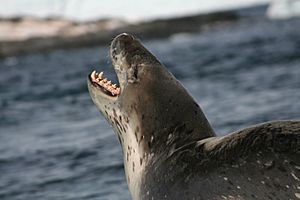
"Challenges of Life" documents the capture of a young chinstrap penguin by a leopard seal (pictured).
This first episode introduces the series. It shows amazing examples of how animals find food, hunt, find mates, and raise their young from all over the world.
|
||||
| 2 | "Reptiles and Amphibians" | 19 October 2009 | 4.93 million viewers (18.9% audience share) | |

"Reptiles and Amphibians" documents how a group of Komodo dragons (pictured) kill and eventually eat a water buffalo using venom.
This episode explores reptiles and amphibians. It starts with two male Komodo dragons fighting during mating season on Komodo. Even though they seem ancient, reptiles and amphibians are very successful because of their many survival tricks.
|
||||
| 3 | "Mammals" | 26 October 2009 | 5.55 million viewers (21.9% audience share) | |
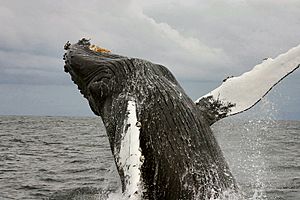
A breaching humpback whale, a species featured in "Mammals".
Mammals are super successful animals because they are smart, warm-blooded, and have strong family bonds.
|
||||
| 4 | "Fish" | 2 November 2009 | 4.56 million viewers (18.1% audience share) | |
|
Fish are the most diverse group of vertebrate animals. They live in the world's rivers, lakes, and oceans.
|
||||
| 5 | "Birds" | 9 November 2009 | 4.33 million viewers (17.6% audience share) | |

"Birds" shows how lammergeiers in the Simien Mountains collect bones from animal carcasses and smash them by dropping them on to rock slabs.
Birds are the focus of this episode. Their feathers help them adapt and fly, making them incredibly versatile.
|
||||
| 6 | "Insects" | 16 November 2009 | 3.80 million viewers (14.6% audience share) | |
|
This episode enters the tiny world of insects. They have many different body shapes, armor, and wings. This has helped them survive and become the most common creatures on Earth.
|
||||
| 7 | "Hunters and Hunted" | 23 November 2009 | 4.04 million viewers (15.9% audience share) | |

A killer whale's unique hunting strategy is revealed in "Hunters and Hunted".
Mammals have developed many different ways to hunt their prey and escape from predators.
|
||||
| 8 | "Creatures of the Deep" | 30 November 2009 | 3.95 million viewers (15.6% audience share) | |
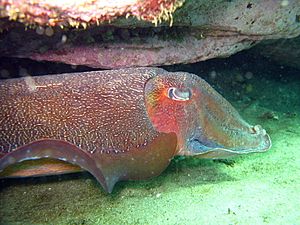
The Australian giant cuttlefish is one of the marine invertebrates featured in "Creatures of the Deep".
Marine invertebrates are animals without backbones that live in the ocean. They have been evolving for a billion years and are the most common creatures in the sea.
|
||||
| 9 | "Plants" | 7 December 2009 | 4.30 million viewers (18.0% audience share) | |
|
Plants face a daily struggle to find water, nutrients, and light.
|
||||
| 10 | "Primates" | 14 December 2009 | 5.14 million viewers (21.9% audience share) | |

Japanese macaques are the most northerly primates, enduring winter temperatures of −20 °C (−4 °F) in the Japanese Alps.
Primates are smart, curious, and live in complex groups. This has helped them live in many different places.
|
||||
More About Life
Inside Life
There was also a TV series for children called Inside Life. It aired on the CBBC Channel. This show followed young volunteers as they went behind the scenes with the Life production team. They even joined the filmmakers on their expeditions! It started airing on October 13, 2009.
One Life Film
In 2011, BBC Earth used footage of animals from Life to create a documentary film called One Life. This film was narrated by Daniel Craig.
DVDs, Blu-rays, and Books
The Life series was released in the UK on DVD and Blu-ray Disc on November 30, 2009. It was also released in other regions later.
A hardcover book was written by the producers, Martha Holmes and Michael Gunton. The book, also called Life, was published in the UK on October 1, 2009.


